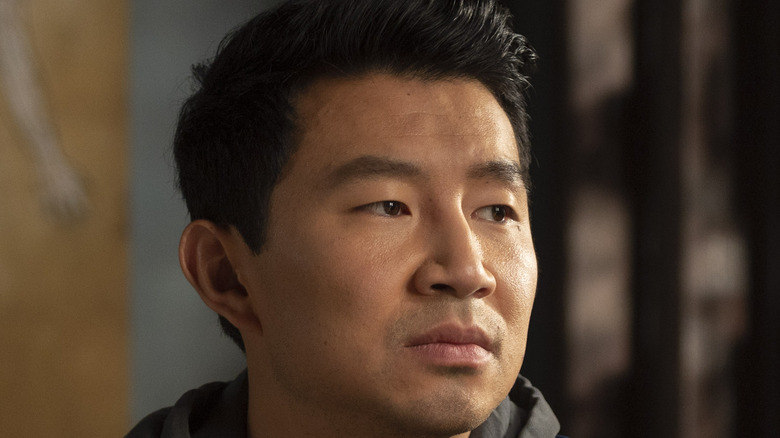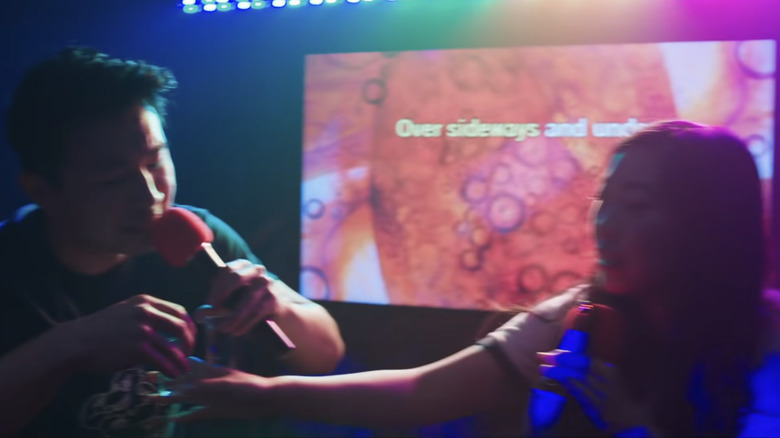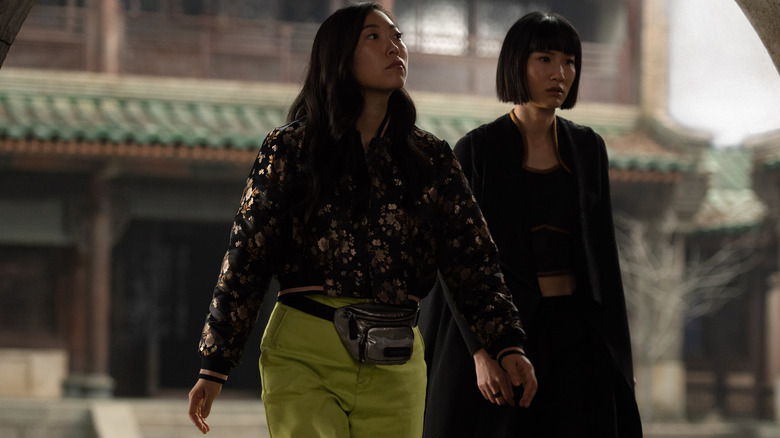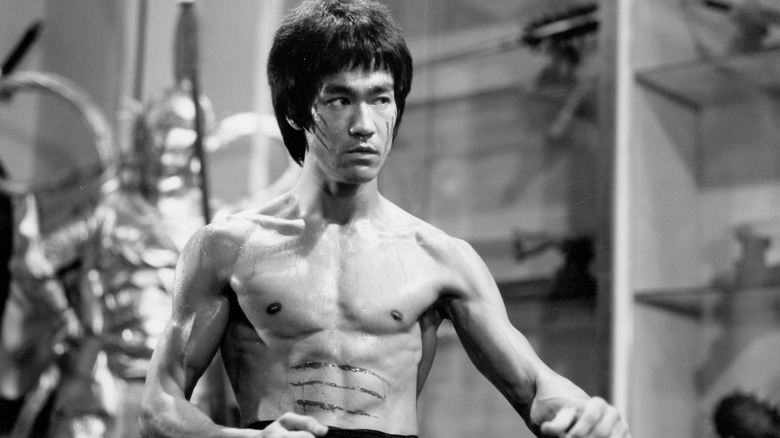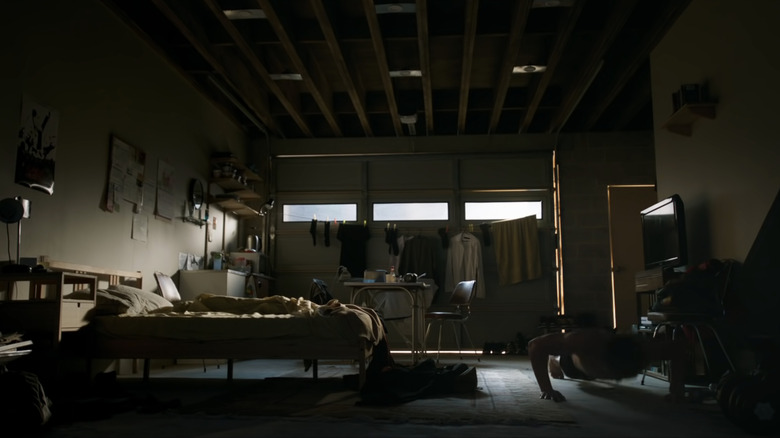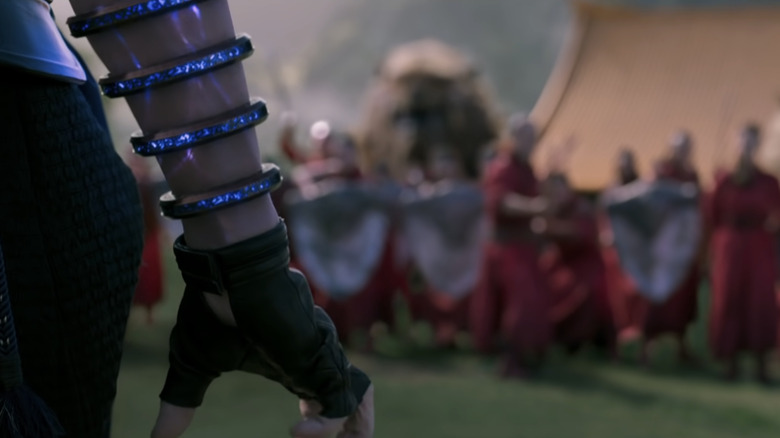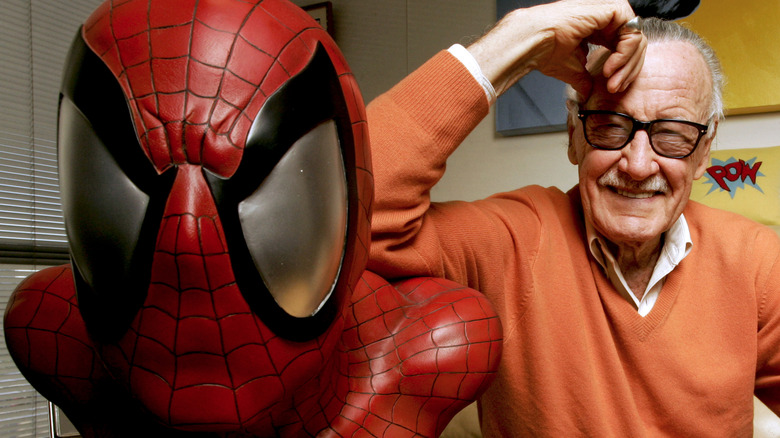Things Only Adults Notice In Shang-Chi And The Legend Of The Ten Rings
An overlooked ingredient in the unprecedented success of the Marvel Cinematic Universe is a simple one: To paraphrase "The Hudsucker Proxy," it's for kids! Now, before you go getting your superhero tights in a bunch, of course the MCU is made for grown-ups as well — there's plenty of adult drama, people dying (RIP Phil Coulson) and romance — but the series excels at existing in that blurred space between PG-13 and R, where most parents feel safe letting their ten-year-old (or younger) accompany them to see the latest Marvel blockbuster.
Faster than you can say "Shrek 7," Hollywood beancounters will tell you that one nerd in a theater seat won't make you nearly as much money as Mom and Dad loving Star-Lord and Gamora while the kids enjoy Groot. It's no knock against Marvel — after decades of Hollywood attempts to harness the power of the mythical "four quadrant" movie, Marvel perfected the formula, and then repeated it 24 times.
Now, the time has come for the 25th Marvel movie, and it might just be one of the most four-quadrant-pleasing films yet. With "Shang-Chi and the Legend of the Ten Ring," parents will adore Awkwafina's jokes about the Eagles, Talbot's clothing store, and NASCAR racing. Kids will love the strange animal with no face and two butts, the flying dragons and machete-hand-guy. The entire family will cheer when Shang-Chi (Simu Liu) saves a city bus, battles ninjas on skyscraper scaffolding, and sings karaoke with Wong.
But of course, not every joke will hit home for every member of the family. So go ahead, pile your troops in the family wagon, and head out to see "Shang-Chi and the Legend of the Ten Rings" at your local theater (using proper safety precautions, of course) — and when you're finished, take a look at this spoiler-heavy breakdown of the references, character baggage and backstories that one quadrant might appreciate more than another.
Some dance to remember, some dance to forget
"On a dark desert highway, cool wind in my hair ..." is the line Awkwafina's Katy screams at an attacker during the Jackie Chan-like scaffolding scene in an attempt to confuse him. It's the closest thing her character has to a superpower (well, until she picks up archery in the film's final act), and it kinda works.
Those ten words will almost certainly resonate with every adult in the "Shang-Chi" audience, who can't help but recognize the introductory line to one of the most popular songs in 20th century adult-oriented album rock. Written and performed by the Eagles (the fourth highest-selling musical artist of all time at 120 million units as of 2020) and released in 1977 on the album of the same name, "Hotel California" won the Grammy for Record of the Year and soared to the number one position on the Billboard charts.
Of course, kids in the "Shang-Chi" audience won't know any of this, as it seems unlikely they're sleeping under a Don Henley poster on their bedroom wall. However, "Hotel California" has become an inescapable part of the American songbook — you might not be rocking the Eagles on Spotify, but you're no less destined to hear the song in an elevator, at the bank or ... you know ... featured prominently in one of the year's biggest blockbuster movies.
Of course, the song comes around again later on, when the good guys have triumphed and Katy and Shaun want to celebrate with Wong — and some karaoke. According to 2021 Spotify data, there's a good chance that "Hotel California" was not only the song chosen by the trio, but also the groups on stage preceding and then following them.
Old-Timer's Day
Like the Eagles' connection, "Shang-Chi and the Legend of the Ten Rings" is stuffed with references more likely to make mom and dad laugh than the kids — but what Marvel always does well is write these lines so everyone can understand the context, regardless of their pop culture prowess. Then again, "pop culture" is stretching things when Katy makes passing reference to Talbot's, a 74-year-old American specialty retailer with more than 400 locations nationwide. The store is best known for being the go-to place to grab a holiday gift card for your grandmother.
In another scene, Shaun is called "Gangnam Style." This attempted slur compared him to Psy, the worldwide sensation who in 2012 set a world record for having the first clip on YouTube to surpass a billion views; as of 2021, the "Gangnam Style" music video had reached 4 billion views, and was the tenth-most viewed and fifth-most liked video on YouTube. Shaun explains that this is both insensitive and ignorant, since he is Chinese and Psy is from South Korea.
Katy also references Jeff Gordon, one of the most influential and decorated drivers in the history of NASCAR. Currently an announcer for Fox NASCAR, Gordon is a four-time Cup Series champion, three-time winner of the Daytona 500, and became the youngest driver to win a NASCAR title at the age of 24. As it turns out, the reference is a bit of foreshadowing, as Katy's obvious enthusiasm for racing later manifests itself in some slick moves behind the wheel of Razor Fist's car while our heroes navigate the magically-shifting jungle around Ta-Lo.
Ten rings, odd origins
Like Captain America or Hulk, the character of Shang-Chi is based on comics that have been around for decades. But his transition to the big screen is unlike any other Marvel hero thus far — because the character's history is littered with delicate subject matter, accusations of cultural exploitation, and characters and motivations who've done more shifting than the trees surrounding Ta-Lo.
To understand the true origins of Shang-Chi, you have to go back to a time and place: comic books in the early 1970's.
When the character first appeared in "Special Marvel Edition" #15 in 1973, the top-selling comic titles included many of the usual suspects: Spider-Man, The Fantastic Four, Thor, Daredevil. Marvel was dominating the industry, but saw growth potential elsewhere: The low-budget, high-grossing hit movies that we look back on today as "exploitation" films.
First came 1971's "Shaft," a landmark in so-called "blaxploitation" cinema that gave birth to 1972's "Super Fly," 1974's "Three the Hard Way" — and in the middle of it all, the June 1972 Marvel debut of Luke Cage. Around the same time, Bruce Lee was breaking into the United States market, filming "Enter the Dragon" in 1973 but dying six days before its July 26th release that year. The film nonetheless became a phenomenon, grossing $350 million worldwide on an $850,000 budget and inspiring everything from hit disco singles to posthumously-made Bruce Lee rip-offs to hit TV series and a full-blown martial arts "fad."
It's easy now to look back on those movements as condescending, money-grabbing, largely-white-financed efforts to co-opt heartfelt sentiment. It's also undeniable that for the first time in popular culture, many Black and Asian audiences were seeing themselves on screen — not as punchlines and purse-snatchers, but as heroes. Marvel leaned into both movements heavily, and Shang-Chi (who starred in his own comic series titled "Master of Kung Fu" for 125 issues) and Luke Cage both became popular characters of the time, resonating with those same audiences while also putting their stories into the hands of kids all races, creeds, and colors over the world.
Which isn't to say those Shang-Chi adventures have aged well. He was originally presented as the son of Fu Manchu, a character who perpetuated "Yellow Peril" stereotypes. Some characters have cringe-inducing names like Fin Fang Foom. His early comics often portrayed Shang-Chi as "subservient," kicking butt in battle but requiring guidance in social situations. As a result of these and other issues in the character's problematic history, Marvel Studios president Kevin Feige has assured fans that Fu Manchu "is not in ['Shang-Chi'] in any way, shape or form," and writer Dave Callaham has revealed that the behind-the-scenes team created a list of racist stereotypes they were determined to "destroy" while scripting the movie.
Of course, there's also the issue of "The Mandarin" name, which some fans perceived as being co-opted for "Iron Man 3" and given to a white character. Marvel would like audiences to believe that they have carefully, lovingly reversed these decades of baggage and brought characters like Shang-Chi and The Mandarin to the big screen in a way 2021 filmgoers can love, enjoy, and respect.
Wearing your influences on your wall
In Shaun's modest apartment at the beginning of the film, he has all the essentials of bachelor life: a bed, a TV, space to do push-ups. He also has some cool posters adorning his walls, which might allude to themes director Destin Daniel Cretton was attempting to tap into for his Marvel debut.
One of the posters is for 2004's "Kung Fu Hustle." Written and directed by Stephen Chow, it's a Chinese action-comedy that follows an aspiring gangster, a poor village, and the colorful characters that orbit them. Often lumped in with "Crouching Tiger, Hidden Dragon" and "Hero" as modern examples of wuxia films that have caught on with American audiences, the film is nonetheless unique in that it brandishes a sense of humor not present in the others. As it turns out, it is a tone very similar to the one struck by "Shang-Chi" as well.
Oh yeah, it also features a character who specializes in fighting with iron rings.
Another poster is perhaps less of an obvious influence on "Shang-Chi and the Legend of the Ten Rings," but no less classic of a film. It's Walter Hill's "The Warriors," which paints a near-futuristic New York ruled by eccentric gangs. Considered a cult classic, the film contains brutal violence, a gleeful nihilistic attitude, and style to spare.
Iron rings are real
Sure, they look cool in the movie. But did you know that iron rings are a real part of multiple martial arts disciplines, used for training in Yau Kung Mun, Jeet Kune Do (which was conceived by Bruce Lee), Hung Gar, and other styles?
Watch any video of a Kung Fu master using iron rings and you'll get an idea of how they can add resistance to arm movements, hardening muscle and strengthening the arms and fists of combatants. Warning: they are extremely noisy, so you might want to leave them at home if you're hoping to preserve the element of surprise against your opponent.
Of course, real life iron rings won't allow the user to throw fire balls, climb up them like steps or throw them like boomerangs. But if the non-magical kind were good enough for Bruce Lee, they'd probably help with your training as well.
This was almost the second Shang-Chi film
These days, Marvel loves to talk about multiverses and alternate realities, so here's a plot that sounds straight out of "What If...?": In some far-away universe, this is actually the second time Shang-Chi has appeared on the big screen, because Stan Lee made a movie in the early '90s with the star of "The Crow."
Of course, this never came to pass — in our reality, anyway. But it is true that the beloved Marvel icon was a big believer in the Shang-Chi character. As Bruce Lee's son Brandon became a rising star in films like "Rapid Fire," Stan Lee became convinced that the key to turning around Marvel's then-flirting-with-bankruptcy reality was to start making movies — and that Brandon Lee as Shang-Chi could kickstart this would-be '90s MCU.
"Stan did believe in the character," Margaret Loesch, former President and CEO of Marvel Productions, told Inverse in 2018. "He used that as an example of the comic that could transition into the movie and television world."
According to Loesch, Lee even went so far as to bring Bruce Lee's widow and her son in to meet with Marvel execs. "I'll tell you the only reason I remember that comic because I wasn't very familiar with it. Stan introduced me to Linda, the widow of the great Bruce Lee, and Brandon Lee, his son. They came to our Marvel offices," she recalled. "Stan had great hope [for Brandon]. He thought Brandon would be a future star."
Of course, Brandon Lee died in 1993 on the set of "The Crow," a hit film released posthumously — creating eerie parallels with his father, who had made the Shang-Chi phenomenon possible in the first place. Also worth noting: "The Crow" was based on a comic book — which might just be an indication that Brandon Lee's "Shang-Chi" was indeed a hit in that supposed far-away universe, kicking off an MCU two decades before Robert Downey Jr. ever strapped on a metal suit.
